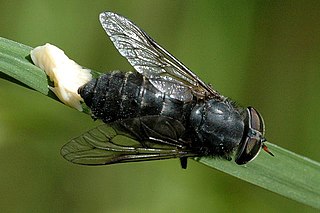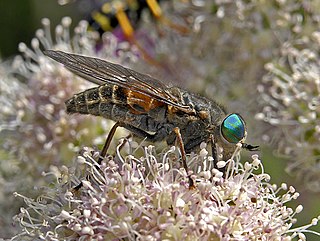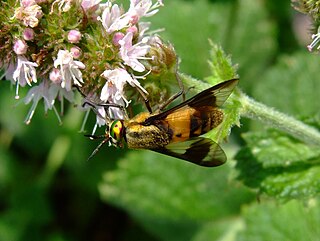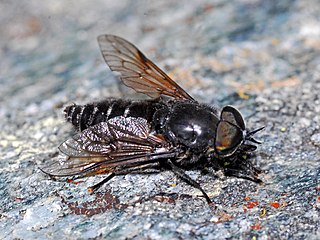
Tabanus bromius, sometimes called the band-eyed brown horsefly, is a species of biting horseflies.

Tabanus glaucopis, also known as the downland horsefly, is a species of biting horse-fly.

Tabanus maculicornis also known as the narrow-winged horsefly is a species of biting horse-fly.
Tabanus spodopterus also known as the black horned giant horsefly is a species of biting horse-fly. It is widespread in Europe, but only one doubtful specimen has been found in the United Kingdom.

Philipomyia aprica is a species of horse fly of the family Tabanidae, subfamily Tabaninae.

Chrysops caecutiens, common name splayed deer fly, is a species of horse fly belonging to the family Tabanidae. It is also known by the colloquial name Scotch Cleg.

Tabanus quatuornotatus is a species of biting horse-fly.

Hybomitra micans is a species of horse flies in the family Tabanidae.

Hybomitra montana, the slender-horned horsefly, is a species of horse flies in the family Tabanidae.

Chrysops viduatus is a species of 'horse flies' belonging to the family Tabanidae.

Hybomitra muehlfeldi is a species of horse flies belonging to the family Tabanidae. It is a Palearctic species with a limited distribution in Europe.

Therioplectes gigas is horse fly in the family Tabanidae. The species was first described by Johann Friedrich Wilhelm Herbst in 1787.
Hybomitra lurida is a species of horse-fly in the family Tabanidae. It is found across central and Northern Europe and Asia. It is a large fly, between 12–15 millimetres long.
Hybomitra expollicata, also known as the striped horsefly, is a Palearctic species of horse fly in the family Tabanidae.
Hybomitra solstitialis is a Palearctic species of horse fly in the family Tabanidae. Continental authorities apply the name solstitialis to the coastal species Hybomitra ciureai of British authorities and regard British solstitialis as var. collini of Hybomitra bimaculata.

Dasyrhamphis umbrinus is a species of horse fly, a fly in the family Tabanidae, native to Europe and near East Asia.

Hybomitra caucasica is a species of horse flies in the family Tabanidae.
Hybomitra eberi is a species of horse flies belonging to the family Tabanidae. It is a Palearctic species.
Hybomitra auripila is a Palearctic species of horse fly in the family Tabanidae.
















